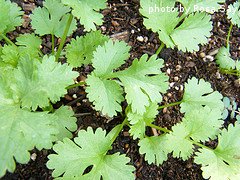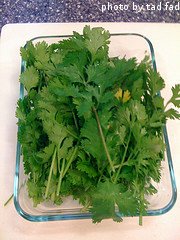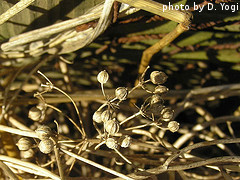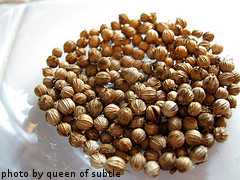Harvesting Cilantro
When harvesting cilantro, it's important not to pick too many stems at a time. This will weaken the plant and future production will be poor. If you wait to harvest the coriander seeds, it doesn't matter if you do damage to the plant, as it is near the end of its life cycle anyway.
Cilantro is one of the few things we grow that we like to harvest in the early morning, when the dew is still on the plants. We find that the added weight from the moisture helps separate the stems just a little bit, which gives us a better idea of which ones we want to cut off. We also find that cilantro stems that are moist when harvested tend to last a little bit longer in the fridge.
Harvesting Cilantro

Each cilantro plant grows from the center and develops stems that branch out. It's best to harvest just the outer stems. This leaves the center of the plant undisturbed, allowing for future growth. When harvesting cilantro stems, use a knife or shears and cut them off near ground level. Be careful not to accidentally cut the center stem. It's also a good idea to only harvest no more than about 1/3 of the stems at a time, leaving enough to keep the plant strong and healthy. If you aren't going to need any more than a few stems, cut only what you think you'll need in the next day or two. The rest of the stems can be left on the plant to be picked later.
It's best to use cilantro as soon as possible after you harvest it. Rinse off the stems and leaves with water. Pluck the leaves from the stem. Before adding cilantro to any recipe or dish, roughly chop the leaves. This will release more flavor and aroma that is stored in the oil inside the leaves.

If you need to wait a few days before using cilantro, don't rinse off the stems and leaves. Just bundle the stems with a rubber band and place them in the refrigerator. You can also store the stems in a vase with the bottoms sitting in a little bit of water. They will stay fresh for 2-3 days maximum before starting to wilt.
Cilantro leaves lose most of their flavor and aroma if they are dried. To store fresh cilantro leaves long term, freeze the leaves in cubes of water. We like to pack quite a few leaves into each section of an empty ice cube tray. We then fill them up with water and freeze them. When the cubes are frozen, we like to take them out of the trays and store them in an air-tight bag.
When used, frozen cilantro leaves don't taste as good as fresh ones, but they are much better than dried leaves. You can also add freshly chopped cilantro leaves to butter, using 1 part cilantro leaves to 2 parts butter. This butter can be frozen for later use. When we freeze cilantro butter, we use silicone ice cube trays, just because it makes it easier to remove the butter cubes later. We roughly chop the leaves and then mix them into softened, salted butter. We then pile the butter into the ice cube tray, filling up each section to the top and smoothing it out. After freezing overnight, we take the butter cubes out of the tray and store them in an air-tight bag in the freezer.
Harvesting Coriander Seeds

Coriander seeds are harvested near the end of the plant's life cycle. They are easiest to pick on a dry day. Inspect the seed pods to make sure they are brown and easily cracked open. The idea is to harvest the seed pods before they are dropped from the plant. Use a knife or shears to cut the stem below the cluster of seed pods. Place the cut stems upside down in a paper bag. Some of the the seed pods will release their seeds into the bottom of the bag within a couple of a days. The remaining pods can be rolled around in the palm of your hand. They will break open, releasing the seeds.

Coriander seeds should be stored whole in an airtight container in a cool, dark area of your kitchen. They can also be stored in the refrigerator. Coriander seeds will stay fresh for up to a year. They can be used whole or you can grind them up, depending on what the recipe you are using calls for.
Now that you've learned about harvesting cilantro and coriander seeds, it's time for a few of our favorite recipes that feature both ingredients.
Click here for some of our favorite coriander and cilantro recipes
Click here to move from our Harvesting Cilantro page to our Growing Cilantro main page
Click here to go to our Home page